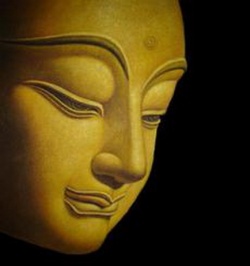View
View or position (Pali diṭṭhi, Sanskrit dṛṣṭi) is a central idea in Buddhism.[1] In Buddhist thought, in contrast with the commonsense understanding, a view is not a simple, abstract collection of propositions, but a charged interpretation of experience which intensely shapes and affects thought, sensation, and action.[2] Having the proper mental attitude toward views is therefore considered an integral part of the Buddhist path.[3]
Positions
Views are produced by and in turn produce mental conditioning. They are symptoms of conditioning, rather than neutral alternatives individuals can dispassionately choose.[4] The Buddha, according to the discourses, having attained the state of unconditioned mind, is said to have "passed beyond the bondage, tie, greed, obsession, acceptance, attachment, and lust of view."[5]
The Buddha of the early discourses often refers to the negative effect of attachment to speculative or fixed views, dogmatic opinions, or even correct views if not personally known to be true. In describing the highly diverse intellectual landscape of his day, he is said to have referred to "the wrangling of views, the jungle of views."[6] He assumed an unsympathetic attitude toward speculative and religious thought in general.[7] In a set of poems in the Sutta Nipata, the Buddha states that he himself has no viewpoint. According to Steven Collins, these poems distill the style of teaching that was concerned less with the content of views and theories than with the psychological state of those who hold them.[8]
Those who wish to experience nirvana must free themselves from everything binding them to the world, including philosophical and religious doctrines.[9] Right view as the first part of the Noble Eightfold Path leads ultimately not to the holding of correct views, but to a detached form of cognition.[10][11]
Four wrong views
Gyurme (1987: p. 1431) in his treatise on the principal Nyingma Mahayoga tantra, the Guhyagarbha Tantra and its detailed Dzogchen commentary by Longchenpa, conveys the following 'four false views' (Tibetan: ཕྱིན་ཅི་ལོག་བཞི, Wylie: phyin ci log bzhi) they are inappropriate subtle 'activities' (Wylie: phyin) of the mindstream formed from 'habitual patterns' (Sanskrit: vāsanā) that collapse the 'expanse of possibility' or 'openness' (Sanskrit: sunyata) into structures of fixed views or 'formations' (Sanskrit: saṅkhāra) in regards to 'purity of conduct' (Wylie: Śīla), 'suffering' (Sanskrit: dukkha), 'selflessness' (Sanskrit: anatman) and 'impermanence' (Sanskrit: anitya):
The '"four erroneous views" (phyin ci log bzhi) are to apprehend impurity as purity, to apprehend selflessness as self, to apprehend suffering as happiness, and to apprehend impermanence as permanence.[12]
Footnotes
- ↑ Paul Fuller, The Notion of Diṭṭhi in Theravāda Buddhism: The Point of View. Routledge, 2005, page 1.
- ↑ Dan Lusthaus, Buddhist Phenomenology. Routledge, 2002, page 242, note 46.
- ↑ Paul Fuller, The Notion of Diṭṭhi in Theravāda Buddhism: The Point of View. Routledge, 2005, pages 1-2.
- ↑ Dan Lusthaus, Buddhist Phenomenology. Routledge, 2002, page 242, note 46.
- ↑ Paul Fuller, The Notion of Diṭṭhi in Theravāda Buddhism: The Point of View. Routledge, 2005, page 2.
- ↑ Peter Harvey, Buddhist Ethics. Cambridge University Press, 2000, pages 239-240.
- ↑ Gunnar Skirbekk, Nils Gilje, A history of Western thought: from ancient Greece to the twentieth century. 7th edition published by Routledge, 2001, page 25.
- ↑ Steven Collins, Selfless Persons. Cambridge University Press 1990, page 129.
- ↑ Gunnar Skirbekk, Nils Gilje, A history of Western thought: from ancient Greece to the twentieth century. 7th edition published by Routledge, 2001, page 25.
- ↑ Paul Fuller, The Notion of Diṭṭhi in Theravāda Buddhism: The Point of View. Routledge, 2005, page 2.
- ↑ Bhikkhu Bodhi, [1].}
- ↑ Gyurme Dorje (1987). The Guhyagarbhatantra and its XIVth Century Commentary Phyogs-bcu mun-sel. PhD Thesis. SOAS, University of London. Source: [2] (accessed: Sunday October 25, 2009).
